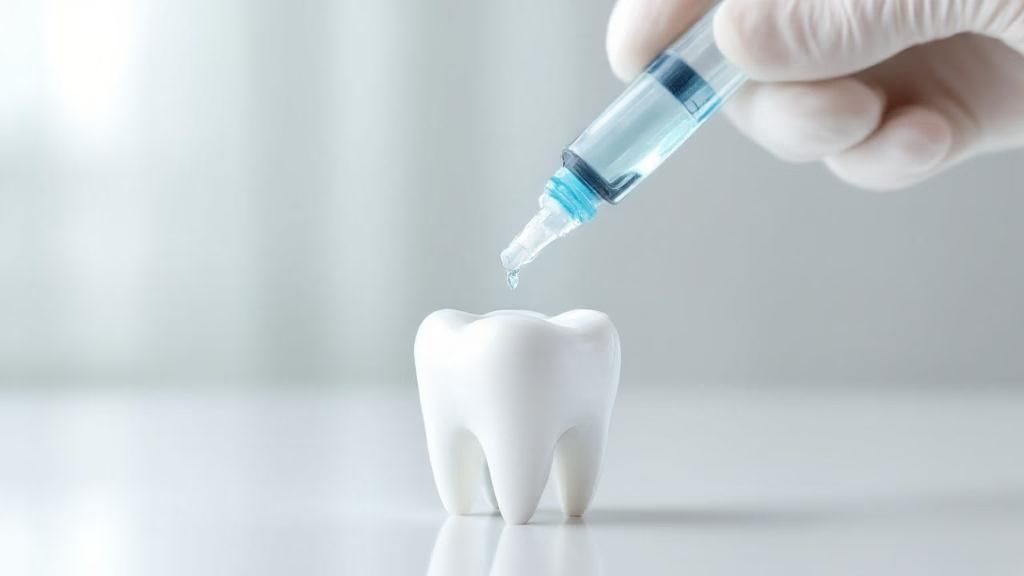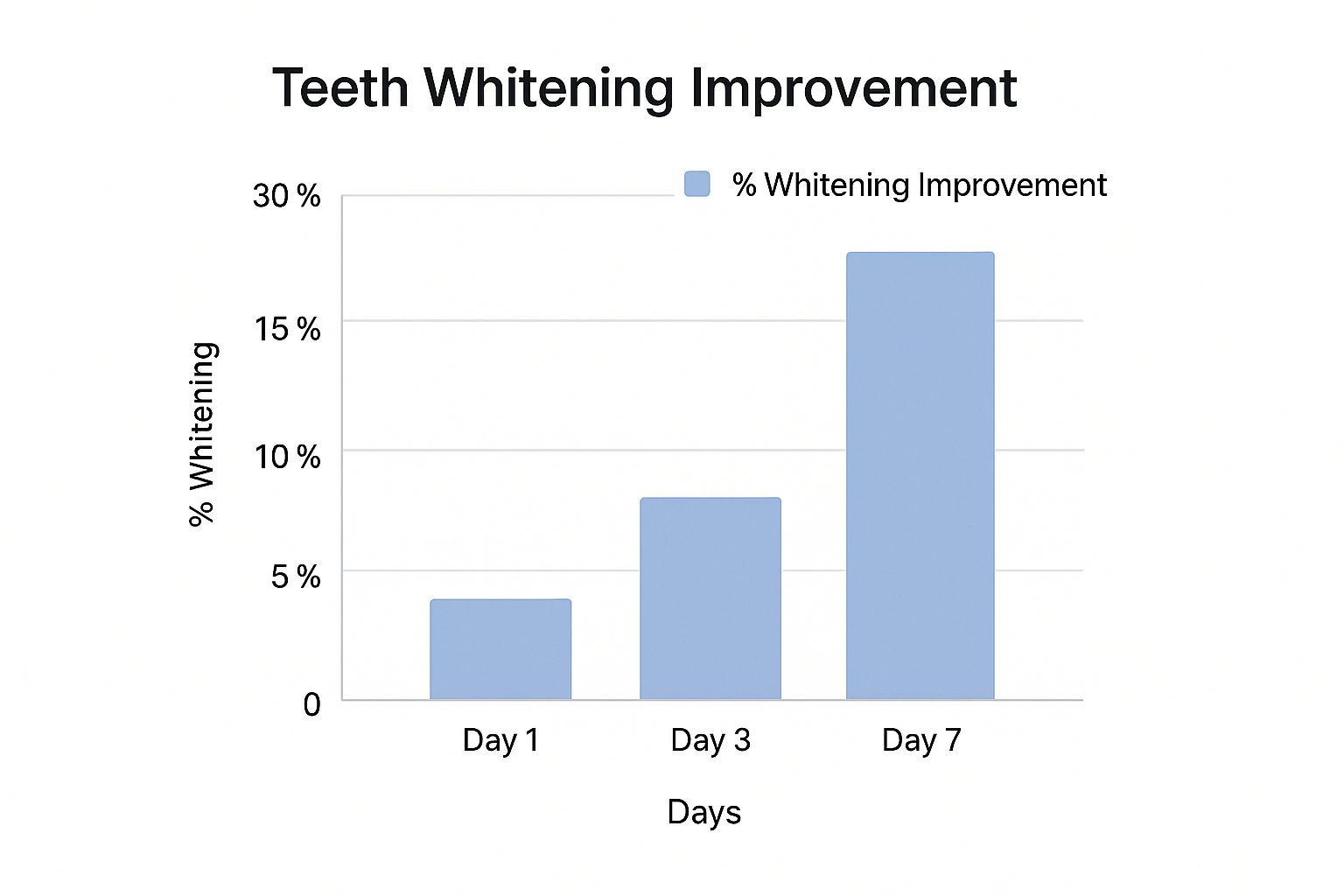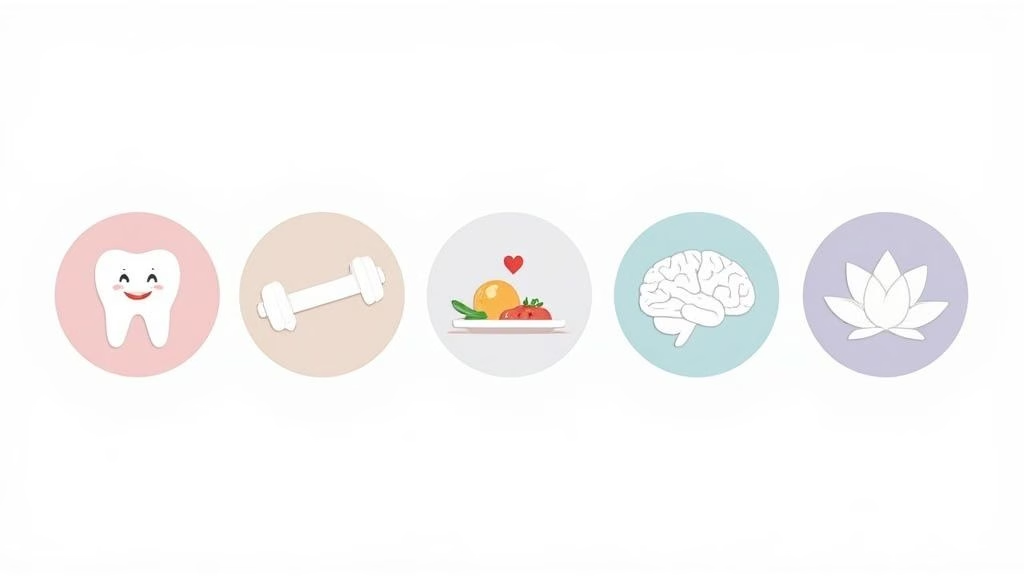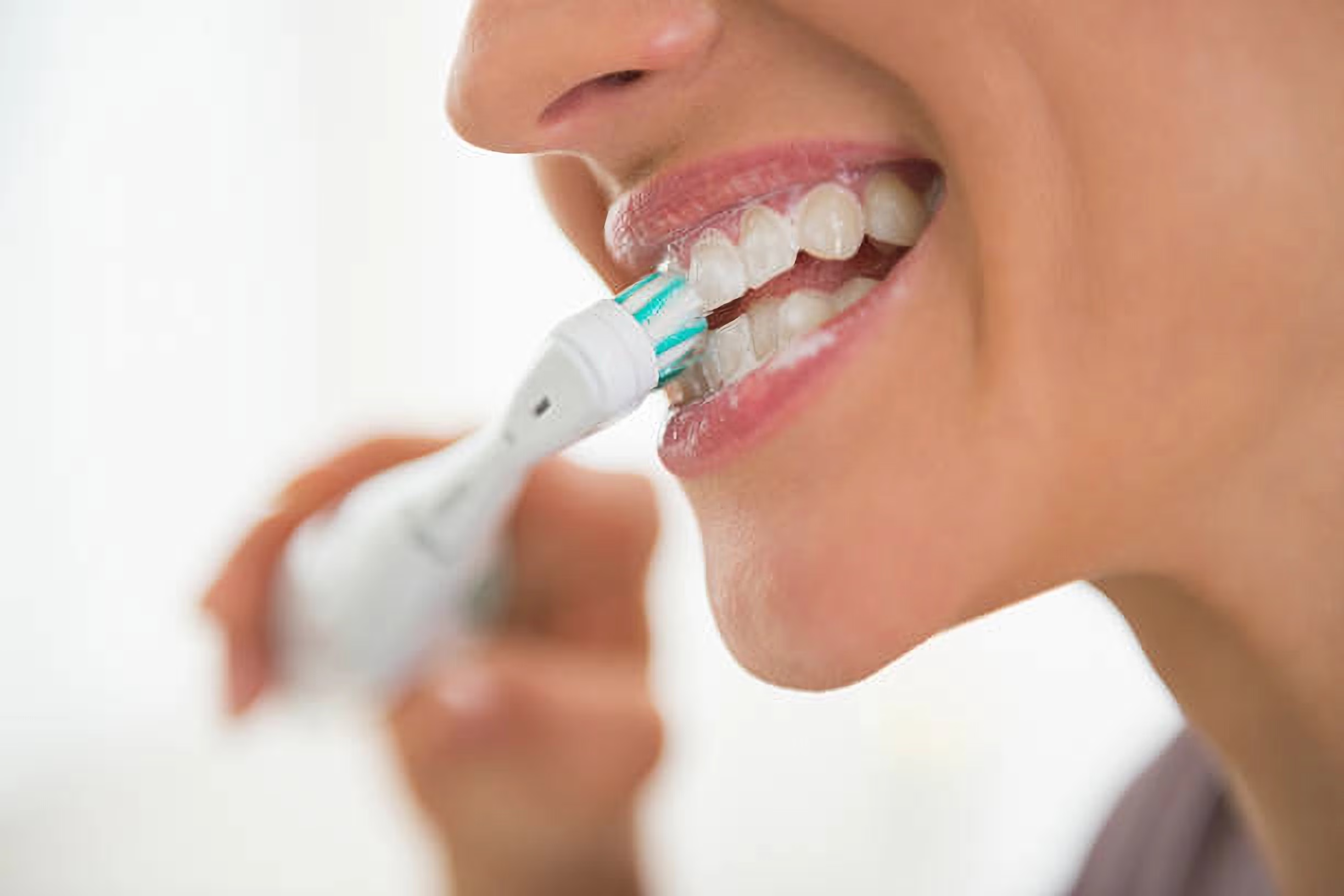A Guide to Teeth whitening Gel with Peroxide

A brighter, more confident smile often feels just out of reach, but the key might be simpler than you think. When it comes to getting professional-level results at home, teeth whitening gel with peroxide is the undisputed champion. It’s the active ingredient that dentists trust to safely break down years of stubborn stains, revealing the brilliant, natural smile hiding underneath.
The Secret to a Brighter Smile at Home
Getting that luminous smile used to mean booking expensive and time-consuming trips to the dental clinic. Not anymore. With the rise of genuinely effective at-home cosmetic treatments, the power to transform your smile is now literally in your hands, which is why it’s become such a popular choice across the UK.
The desire for accessible cosmetic dental products is booming. In fact, the UK teeth whitening market was valued at a huge USD 248.3 million in 2023 and is on track to hit USD 387.3 million by 2030, with gels and strips leading the charge. You can dive deeper into this market trend on Grand View Research.
This guide is here to pull back the curtain on how teeth whitening gel with peroxide actually works. We’ll explore why it’s so effective and, most importantly, how you can use it safely to get the results you’re after. Let’s break down the science in a straightforward way, so you can start your journey with total confidence.
A Smarter Path to Cosmetic Dentistry
For years, getting a “perfect” smile meant one of two things: expensive in-clinic procedures or a specific aligner brand that came with a premium price tag and a calendar full of appointments. Thankfully, that old-school approach to cosmetic dentistry is changing for the better.
Pioneers like Toothfairy are completely changing the game by making advanced dental care both affordable and accessible. By blending professional dental oversight with the sheer convenience of at-home treatments, it’s never been easier to achieve the smile you’ve always wanted. This modern approach is simply a smarter way forward for teeth straightening, cosmetic work, or even dental emergencies.
It offers:
- Convenience: You get to use professional-grade treatments that fit seamlessly into your life, right from the comfort of your own home.
- Affordability: It’s a far more cost-effective route compared to the traditionally expensive in-clinic options.
- Professional Guidance: Every step is dentist-prescribed and monitored, ensuring your treatment is both safe and effective.
This shift puts you back in the driver’s seat of your cosmetic dental journey. Whether you’re interested in teeth straightening or whitening, the old barriers of high costs and inconvenience are finally coming down.
How Peroxide Safely Whitens Your Teeth

The secret to a whiter smile isn’t really magic—it’s just clever chemistry. A good teeth whitening gel with peroxide works by getting past the outer surface of your tooth, the enamel. Think of your enamel as a sponge; it’s full of microscopic pores. That’s exactly how stains from things like coffee, tea, and red wine get lodged in there to begin with.
Once the peroxide gel is applied, its active ingredients get to work. These tiny molecules travel into the pores and kick off a chemical reaction called oxidation. It’s like sending in a specialist cleaning crew that only targets the discoloured molecules responsible for the stains. The process breaks down the chemical bonds holding the stains in place, essentially neutralising them on the spot.
As those stain molecules are dismantled, they lose their colour. This is what lightens your teeth from the inside out, revealing their natural, brighter shade. It’s a much more effective approach than just scrubbing at the surface; you’re erasing the stains at a deeper level for a truly brighter smile.
The Two Main Types of Peroxide
When you start looking into whitening products, you’ll see two main types of peroxide pop up again and again. They both get you to the same destination—whiter teeth—but they take slightly different routes.
- Hydrogen Peroxide: This is the direct, fast-acting option. It breaks down very quickly to release its whitening agents, which is why you’ll often find it in products designed for rapid results.
- Carbamide Peroxide: This one is a bit different. It’s a more stable compound that works at a slower, more controlled pace. It first breaks down into hydrogen peroxide and urea, and then the whitening process begins. This gradual release is generally considered gentler on teeth, making it a fantastic choice if you have any sensitivity.
One of the biggest differences is their relative strength. Carbamide peroxide is about one-third as potent as hydrogen peroxide. To put it another way, a gel with 10% carbamide peroxide provides a similar whitening effect to a gel with about 3.5% hydrogen peroxide. This is a key reason why carbamide peroxide is so popular in at-home kits meant to be worn for longer periods.
The Power of Oxidation
The science here is actually pretty straightforward. The peroxide in the gel releases highly reactive oxygen molecules. These molecules are small enough to seep into both the enamel and the dentin layer underneath, which is where many of the tougher, deep-set stains live.
Once inside, they find the large, dark-coloured stain molecules and break them apart into smaller, completely colourless ones. This oxidation reaction is precisely what makes a teeth whitening gel with peroxide so effective. The newly created smaller molecules reflect more light, making your teeth appear noticeably whiter and brighter. It’s not just a surface fix; the change comes from within the tooth structure, giving you a result that looks both natural and radiant.
Choosing the Right Peroxide Strength
Picking a teeth whitening gel with peroxide can feel like you’re back in a chemistry lesson, but getting your head around those percentages is crucial for getting the bright smile you want, safely. The concentration of peroxide is the single biggest factor determining how powerful the gel is, how fast it works, and whether it’s right for your teeth.
Go for a higher percentage, and you’ll likely see faster, more dramatic results. The catch? It also increases the chances of tooth sensitivity. On the other hand, lower concentrations are much kinder to your teeth, making them perfect for anyone with a sensitive mouth or for those dipping their toes into whitening for the first time. The results might take a little longer to show, but it’s a far more comfortable journey. It’s the classic trade-off: speed versus comfort.
Just look at how a gentle, consistent approach can make a real difference in only a single week.

Even with a gentle formula, consistent daily use can lead to a 30% improvement in just seven days. It’s proof that you don’t need harsh chemicals to see progress.
Finding Your Perfect Balance
Here in the UK, the strength of at-home whitening kits is tightly regulated, and for good reason. It’s all about keeping you safe. Gels that are too strong can cause some nasty gum irritation and painful sensitivity if you’re not being monitored by a professional. This is exactly why a dentist-led service like Toothfairy is a much smarter move than grabbing an unregulated, high-strength kit online.
The UK teeth whitening market, valued at around £24.7 million in 2023, is dominated by gels with peroxide levels between 3% and 10%. This range has been proven to be both safe and effective for people to use at home. If you’re interested in the details, you can discover more insights about the UK teeth whitening market and see how these regulations protect consumers.
This careful, measured approach means you can get fantastic results without putting your oral health at risk. When a dentist prescribes your gel, they’ll choose a concentration that gets the job done while minimising any potential side effects.
Comparing Peroxide Concentration Levels
To give you a clearer picture of what might work for you, it helps to see how the different strength levels in regulated, at-home kits stack up.
The table below breaks down the typical concentrations you’ll find in the UK and who they’re best suited for.
| Concentration Level | Typical Peroxide % (UK) | Best For | Key Considerations |
|---|---|---|---|
| Low | 3% – 6% Carbamide | First-timers and people with sensitive teeth. | A gentler option, though results will appear more gradually. |
| Medium | 6% – 10% Carbamide | Most people looking for noticeable whitening. | A great middle-ground, balancing speed with comfort. |
| High | 10%+ Carbamide | Seasoned whiteners with no sensitivity issues. | Delivers the fastest results but has a higher risk of irritation. |
Ultimately, choosing the right strength isn’t just about picking the highest number. This table shows there’s a careful balance to be struck between your whitening ambitions and your dental health.
The most important thing to remember is this: stronger isn’t always better. The right strength for you is completely personal. It depends on your dental history, how sensitive your teeth are, and what you want to achieve. That’s why getting professional guidance is priceless—it takes all the guesswork out of the equation and makes sure your treatment is perfectly suited to you, helping you avoid the pain and discomfort that can come from a gel that’s simply too powerful.
Your Step-By-Step Whitening Application Guide
Getting the best out of your teeth whitening gel with peroxide comes down to knowing how to use it properly. When you get the application right, you not only see incredible results but also make the whole experience safe and comfortable. It’s less of a clinical procedure and more of a simple routine that leads to a brilliant smile.
Think of this as your personal walkthrough. We’ll go through every stage, from getting your teeth ready to the final rinse, so you can feel like you know exactly what you’re doing. By following these pointers, you can sidestep common mistakes and make sure every treatment counts.
Preparing Your Teeth for Treatment
Before you even reach for the whitening gel, a bit of prep work makes all the difference. For the peroxide to do its job, it needs to get right up against your tooth enamel. If there’s any plaque or food particles in the way, they act like a tiny shield, which can leave you with patchy, uneven whitening. Nobody wants that.
Here’s how to get your teeth perfectly prepped for their whitening session:
- Brush and Floss Thoroughly: Give your teeth a really good clean. That means brushing for a full two minutes, making sure you get to every nook and cranny, followed by a good floss to clear out anything hiding between your teeth. This gives the gel a clean, fresh surface to work on.
- Rinse and Dry: Once you’re done brushing, have a good rinse with water to wash away any leftover toothpaste. Then, grab a clean tissue or cloth and gently pat your teeth dry. A dry surface helps the gel stick to your enamel and start its magic right away.
Applying The Peroxide Gel
Okay, your teeth are clean, dry, and ready to go. Now for the gel itself. The number one rule here is simple: less is more. One of the most common slip-ups is putting too much gel in the whitening trays, which is the main reason people experience gum irritation. You want to coat your teeth, not your gums.
Start by placing a small, single bead of gel into the part of the tray for each tooth. A teardrop-sized dot is usually perfect. Don’t forget, once the tray is in your mouth, the gel will naturally spread out and cover the whole tooth.
Pro Tip: Try applying the gel only to the front-facing part of each tooth compartment in your tray. This is your “smile zone” and the area you’re focused on brightening. It’s a clever little trick that helps stop excess gel from oozing onto your gums when you pop the tray in.
With the trays loaded, place them gently over your teeth. They should feel snug but not uncomfortably tight. If you see a lot of gel squishing out onto your gums, take the trays out, use a cotton bud to wipe the excess away, and just remember to use a little less gel next time.
This careful technique is the cornerstone of a safe and effective treatment, something that dentist-guided services like Toothfairy champion. Sticking to the wear time recommended by your dentist is just as important for getting to your dream shade without any issues.
Worried About Sensitivity? Here’s How to Keep Your Gums and Teeth Happy
One of the most common questions people ask before starting a whitening treatment is, “Will it make my teeth sensitive?” It’s a fair question, and while some temporary sensitivity can happen with peroxide-based gels, it’s usually mild, short-lived, and completely manageable.
Think of it this way: to lift those deep-set stains, the peroxide needs to open up the tiny, microscopic pores in your enamel. This can momentarily make the delicate nerve endings inside your teeth a little more reactive to hot or cold temperatures. For some, it’s a normal part of the process, but it doesn’t have to be uncomfortable.
Your gums need a bit of care, too. If you overfill your whitening trays, the extra gel can squeeze out and sit on your gumline. This can sometimes lead to temporary irritation or a slight blanching (whitening) of the gum tissue.
Simple Fixes for a Comfortable Whitening Experience
The good news is that preventing sensitivity and protecting your gums is incredibly straightforward. A little bit of prep work and attention to detail can make all the difference, ensuring your path to a brighter smile is a smooth one.
Here are a few expert-backed tips that really work:
- Switch Your Toothpaste: A week or so before you start whitening, begin using a toothpaste designed for sensitive teeth. Keep using it throughout your treatment for continuous relief.
- Give Your Teeth a Break: If you start to feel a twinge of sensitivity, just switch to whitening every other day. This gives your teeth a little recovery time between sessions.
- Shorten Your Wear Time: You can also cut back on how long you wear the trays each time. Every session adds up, even if it’s a bit shorter.
It’s worth remembering that regulations in the UK are there to protect you. Over-the-counter peroxide levels are capped at 6% or less. This helps strike the right balance between getting great results and keeping you safe, significantly lowering the risk of severe sensitivity. For a deeper dive into these standards, the latest teeth whitening market research offers some great insights.
By following these simple guidelines, especially with a professionally guided system like Toothfairy, you’re set up for a treatment that’s not just effective, but safe and comfortable too. It’s all about getting the cosmetic results you want without sacrificing your comfort along the way.
A Smarter Way to Whiten with Toothfairy
Getting a brighter smile isn’t a standalone project; it’s one piece of your overall oral health picture. While a peroxide-based teeth whitening gel is brilliant for lifting stains, the best and most lasting results come when whitening is part of a bigger plan. This is precisely where our approach at Toothfairy comes in.
We think about cosmetic dentistry a little differently. Instead of viewing teeth whitening and straightening as two separate, often expensive, treatments, we combine them into one seamless journey. It’s a far more intelligent and budget-friendly way to get the smile you’ve always wanted, breaking away from the old model of costly clinic visits or less affordable aligner systems.
Combining Whitening with Teeth Straightening
One of the most common questions we get is when to whiten – before, during, or after straightening? If you’re using clear aligners, the answer is wonderfully simple: you can do both at the same time. Your aligners double up as perfect, custom-made whitening trays, making sure the gel is applied evenly across every tooth.
This is a massive step up from traditional braces, where brackets get in the way and often lead to a patchy, uneven finish. With our dentist-led process, we make sure your whitening and straightening goals are perfectly in sync from day one.
Imagine finishing your teeth straightening journey not just with beautifully straight teeth, but brilliantly white ones too. That’s the power of an integrated plan—you get to your end goal faster and with a lot less fuss.
Affordable, Dentist-Guided Care from Home
The whole idea behind Toothfairy is to bring professional dental care into your home, without the usual expense and hassle. We provide professional-grade whitening gels that are prescribed and overseen by qualified UK dentists, but you use them on your own schedule.
Here’s what that means for you:
- Proper Professional Oversight: A real dentist is with you every step of the way, making sure your treatment is safe and right for your specific needs.
- Unbeatable Convenience: Forget endless trips to the clinic. Your entire plan is managed right from our app.
- A Complete Smile Makeover: We help you build a plan where whitening works hand-in-hand with other treatments, like straightening, to give you the best possible result.
With Toothfairy, you’re not just getting a product off the shelf. You’re stepping into a smarter, dentist-backed system designed for your entire oral health journey.
Common Questions About Peroxide Gels
Even when you’ve got the basics down, it’s completely normal to have a few lingering questions about using a teeth whitening gel with peroxide. Getting clear, honest answers is the best way to feel confident as you start your journey towards a brighter smile. Let’s tackle some of the most common queries we hear.
How Long Do Results from Peroxide Whitening Last?
The staying power of your newly brightened smile really comes down to your daily habits. For most people, you can expect the results from a good peroxide gel to last anywhere from a few months up to a full year. But that timeframe isn’t set in stone.
Lifestyle is the biggest factor here. If you’re a fan of coffee, tea, red wine, or use tobacco, you’ll probably find that new stains creep back in more quickly. Think of it like a freshly laundered white shirt—the more you avoid potential spills, the longer it stays looking crisp. To keep your smile looking its best, great oral hygiene is non-negotiable, and a little touch-up treatment every now and then can work wonders.
Can Peroxide Gels Affect Crowns or Veneers?
This is a really important one. Peroxide gels are formulated to work on the porous surface of your natural tooth enamel. The key thing to know is that they are not effective on dental restorations like crowns, veneers, or fillings.
These materials are man-made and non-porous, and their colour is set during manufacturing. The gel simply can’t penetrate them to lift stains. If you have restorations on your front teeth, whitening your natural teeth could create an obvious colour difference between them. That’s why it’s always best to chat with a dental professional—like the experts at Toothfairy—before starting any whitening treatment. They can help you come up with a plan for a seamless, natural-looking finish.
Can I Whiten My Teeth If They Are Sensitive?
Yes, you can—it just calls for a slightly different game plan. For sensitive teeth, the trick is to take a “slow and steady wins the race” approach rather than going for the most dramatic results overnight.
Here are a few tips to make whitening a more comfortable experience:
- Look for a lower peroxide concentration. This will be much gentler on your enamel.
- Space out your treatments. Whitening every other day instead of daily gives your teeth a break and time to recover.
- Use a desensitising toothpaste for a couple of weeks before you begin and continue with it throughout your treatment. It really helps to build up protection.
The golden rule is to listen to your body. Pay close attention to the product instructions and don’t hesitate to press pause if you feel any real discomfort. A comfortable journey is just as important as the dazzling result at the end.
Ready to achieve a brighter, more confident smile the smart way? Toothfairy offers dentist-prescribed, professional-grade teeth whitening solutions you can use conveniently at home. Get started with your personalised plan today by visiting https://www.toothfairyapp.co.uk.
Last updated on August 28, 2025

Toothfairy Care Team
Toothfairy, is the world's smartest dental app, that connects patients to a dentist for a range of issues, from emergencies, cosmetics, prescriptions to virtual exams.
Toothfairy Care Team
Toothfairy, is the world's smartest dental app, that connects patients to a dentist for a range of issues, from emergencies, cosmetics, prescriptions to virtual exams.





